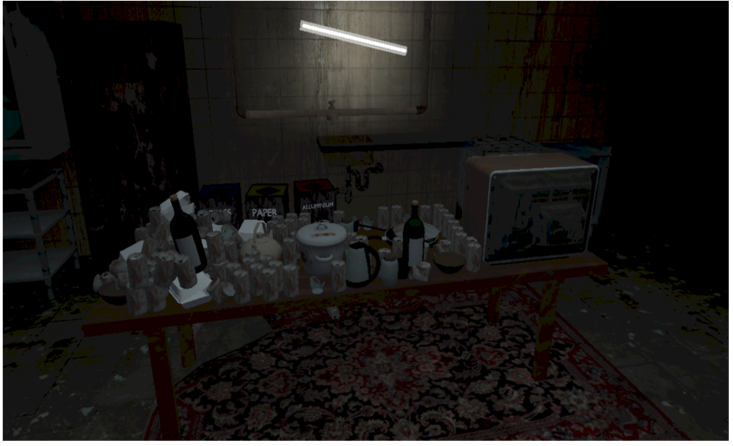Beyond the Jump Scare: How VR Can Adapt to Your Emotions
March 20th, 2025
Aleksandra Zheleva and Samuel Dossche
This blog post builds on our previous research on adaptive VR horror, where we explored stress responses in a haunted VR environment (see this blog post). In this new study, we expanded on that work by introducing anticipation build-ups, testing a larger group of participants, and conducting a more detailed analysis of how users experience and react to stress in different time windows—before, during, and after a jump scare.
If you’ve ever played a horror game in VR, you know that heart-pounding moment when you feel something is coming—your breath shortens, your skin tingles, and then... BAM! The scare hits. But what if the game could sense how scared you were and adapt in real time?
At EMULAB, we’ve been exploring how VR can evolve beyond scripted experiences by using physiological signals—like electrodermal activity (EDA), which tracks stress levels through tiny changes in skin conductivity. Our goal? A VR experience that adapts dynamically to how you feel.
A screenshot from our virtual environment.
What We Found: Anticipation Matters More Than the Scare
Before the Jump Scare: The Build-Up Period
Surprisingly, the biggest physiological shifts happened before the scare. Players who experienced a build-up—subtle cues like eerie music and lighting changes—showed significantly higher tonic EDA features than those without a build-up:
Higher baseline arousal—players were already tense before the scare.
Steeper skin conductance slope—suggesting rising suspense.
Greater stress variability—indicating an unstable physiological state.
However, there were no sharp stress spikes, meaning tension was rising steadily but not peaking—until the scare hit.
The Moment of Impact: The Jump Scare Period
Counterintuitively, players with a build-up showed a smaller jump in stress than those without one:
Their baseline arousal was already high, but the increase was less dramatic.
Key tonic features were lower in the build-up condition.
No strong phasic responses were observed, suggesting that a well-crafted build-up might soften the immediate impact of a scare.
The Aftermath: The Lingering Effects of Fear
Fear didn’t vanish after the scare—it lingered longer for those who had a build-up:
Tonic variability, amplitude sum, and rise times remained elevated.
Stress levels took longer to return to normal.
This suggests that fear isn’t just about the scare itself—it’s about how it builds up and persists afterwards.
Another view of the virtual environment.
What If VR Could Adapt to Your Stress Level?
What if your game knew you were on edge and adjusted accordingly? By tracking stress through EDA, horror games could tailor experiences in real-time. Imagine a game that recognises when you’re too comfortable and dials up the tension—or one that senses when you’re overwhelmed and eases off, creating a personalised experience that keeps you engaged without crossing the line into frustration.
Of course, not everyone reacts to stress in the same way. Some players show strong physiological responses, while others barely register a change. That’s why we believe adaptive VR shouldn’t rely on a single metric like EDA but instead combine multiple sensors—like heart rate variability or muscle activity—to get a fuller picture of each player’s emotional state.
Beyond Horror: How These Insights Apply to Other Fields
The ability to detect emotional states and adapt in real-time isn’t just useful for horror games—it has huge potential for other fields, from education and corporate training to therapy and sports.
Adaptive Learning: Teaching at the Right Pace
Imagine an online learning platform or VR classroom that senses when students are getting bored or overwhelmed. If a student shows signs of frustration (e.g., increased stress levels), the system could slow down or offer extra guidance. If a student appears too relaxed (indicating they might not be challenged enough), the system could introduce more complex material.
Example: A VR medical training simulator could track stress levels in surgeons-in-training, adjusting the difficulty of surgical procedures based on their confidence and skill level.
High-Stakes Training: Stress Management in Real-Time
In professions like firefighting, law enforcement, or military training, the ability to stay calm under pressure is crucial. Real-time physiological tracking could help trainees gradually build resilience to high-pressure situations by adjusting training difficulty in response to their stress levels.
Example: A VR police de-escalation training program could sense when an officer is becoming too stressed and provide real-time feedback on breathing techniques, helping them stay composed in real-world situations.
Mental Health & Therapy: Personalized Exposure Therapy
In cognitive-behavioral therapy (CBT), exposure therapy helps individuals face fears in a controlled environment. VR is already being used for this, but an adaptive system could take it further. If a patient with a fear of heights shows extreme stress, the system could pause or slow down the experience, ensuring they aren’t pushed too hard. If they appear comfortable, the system could increase the challenge slightly, helping them gradually build confidence.
Example: A VR exposure therapy program for anxiety disorders could tailor experiences in real-time, ensuring gradual and personalised progress for each patient.
These insights are based on research conducted by Samuel Dossche, Aleksandra Zheleva and Klaas Bombeke. Stay tuned for an update on the publication with the full results.



